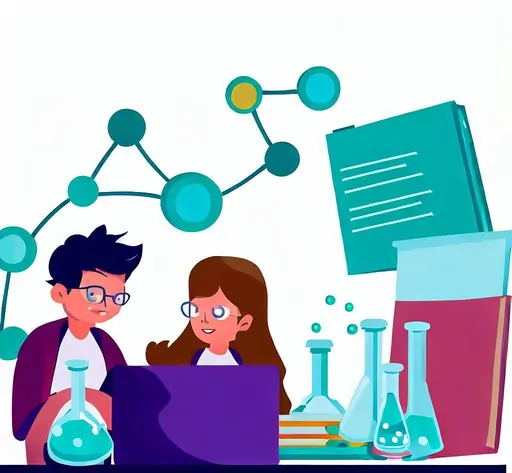Chemical Bonding Made Easy: Strategies for Completing Chemistry Assignments

Chemistry assignments, particularly those involving chemical bonding, can often feel like daunting tasks. However, with the right strategies and a clear understanding of the fundamentals, completing these assignments can become a more manageable and even enjoyable process. In this comprehensive guide, we will explore various techniques and tips to help you complete your chemical bonding assignment. By the end of this blog, you'll have a solid grasp of essential concepts and the confidence to tackle even the most complex chemical bonding assignments.
Understanding the Basics
Before delving into strategies for solving chemical bonding assignments, it's crucial to establish a strong foundation in the basics of chemical bonding. Fundamental concepts include:
Types of Chemical Bonds:

- Ionic Bonds- Ionic bonds are formed when atoms with significantly different electronegativities transfer electrons. The result is the creation of oppositely charged ions—an anion (negatively charged) and a cation (positively charged). These ions are held together by electrostatic forces, forming stable compounds like table salt (NaCl). Ionic bonds are vital in chemistry and biology, contributing to the structure and function of various compounds.
- Covalent Bonds- Covalent bonds involve the sharing of electrons between atoms, creating stable molecules. They are vital in organic chemistry, where carbon forms strong covalent bonds with other elements. Understanding covalent bonds is essential for grasping molecular structures, chemical reactions, and the intricacies of organic compounds, making them a fundamental concept in chemistry education.
- Metallic Bonds- Metallic bonds occur in metals and alloys, where metal atoms share a sea of delocalized electrons. These electrons move freely, creating a unique bond type. Metallic bonds give metals their distinctive properties like electrical conductivity, malleability, and ductility. These characteristics enable metals to be used in various industries, from electronics to construction. Understanding metallic bonds is key to comprehending the behavior of metals.
Bonding Theories:
Bonding theories, such as Lewis Dot Structures, Valence Bond Theory, and Molecular Orbital Theory, provide insights into how atoms combine to form molecules. These theories guide our understanding of chemical bonding, aiding in predicting and explaining molecular structures and properties.
- Lewis Dot Structures- Lewis Dot Structures, a fundamental tool in chemistry, illustrate the arrangement of valence electrons around atoms. By representing electrons as dots, they help visualize covalent and ionic bonds in molecules and ions. These structures enable us to predict the geometry of molecules, identify bonding patterns, and understand chemical reactivity, serving as a foundation for more advanced bonding theories and problem-solving in chemistry.
- Valence Bond Theory- Valence Bond Theory (VBT) explains chemical bonding by focusing on the overlapping of atomic orbitals. When atoms approach each other, their valence electrons' orbitals overlap, forming a shared region where electrons are localized. This theory helps predict the geometry and properties of molecules, offering valuable insights into the nature of covalent bonds and the shapes of molecules in organic and inorganic chemistry.
- Molecular Orbital Theory- Molecular Orbital Theory (MO Theory) is a fundamental concept in chemistry that describes the behavior of electrons in molecules. It combines atomic orbitals to form molecular orbitals, representing the electron distribution in a molecule. MO Theory helps explain bonding, bond order, and molecular stability. It is a powerful tool for predicting the properties and reactivity of various chemical compounds.
Bond Polarity and Electronegativity
Bond polarity arises from differences in electronegativity between atoms in a chemical bond. Understanding bond polarity is crucial for predicting the distribution of charge in molecules, which affects their properties, such as solubility, reactivity, and intermolecular forces.
Bond Length and Bond Energy
Bond length and bond energy are essential parameters in understanding chemical bonds. Bond length is the distance between two bonded atoms, while bond energy represents the energy required to break the bond. These values provide critical insights into a molecule's stability and reactivity.
Resonance and Formal Charge
Resonance and formal charge are essential concepts in chemical bonding. Resonance allows us to depict multiple electron arrangements within a molecule, while formal charge helps identify atom-specific electron distribution, aiding in the determination of the most stable resonance structures and understanding molecular stability.
Organize Your Resources
Organizing your resources is a crucial step in successfully completing chemistry assignments, especially those involving complex topics like chemical bonding. Here's why it matters:
- Firstly, your textbook is your primary reference: It contains explanations, examples, and exercises related to chemical bonding. Familiarize yourself with the textbook's organization and use its index and table of contents to locate relevant sections quickly.
- Secondly, lecture notes provide insights from your class discussions: Reviewing these notes reinforces what you've learned in class and helps you identify the topics your instructor emphasized.
- Thirdly, online resources expand your learning opportunities: Websites like Khan Academy, Coursera, and educational YouTube channels offer video tutorials, practice problems, and supplementary materials. These platforms provide alternative explanations and diverse perspectives, enhancing your understanding.
- Fourthly, consider forming or joining a study group: Collaborative learning can be highly effective. Group discussions allow you to tackle challenging concepts collectively, share insights, and learn from your peers' perspectives.
- Lastly, always have a periodic table on hand: It's indispensable for understanding the properties and electron configurations of elements, which is foundational for comprehending chemical bonding. By organizing these resources effectively, you create a robust support system that simplifies the process of completing your chemistry assignments.
Break Down the Assignment
- Breaking down a chemistry assignment is a crucial step in successfully completing it. When you receive a task related to chemical compounds like H2 (hydrogen gas), the process becomes more manageable with a structured approach.
- Start by carefully reading the assignment instructions. Identify the specific questions or problems you need to address. In the case of H2, you might be asked to determine its molecular structure, properties, or reactions. List these tasks to create a clear checklist.
- Next, review your class notes, textbook, and relevant online resources to gather the necessary information. Ensure you have a solid grasp of the fundamental concepts related to hydrogen, such as its atomic structure, electron configuration, and the nature of covalent bonds.
- Now, it's time to tackle each aspect of the assignment methodically. For H2, you would begin by illustrating its Lewis structure, showing the sharing of electrons between two hydrogen atoms. Then, calculate the formal charge and check for any resonance structures, if applicable.
Consider any additional questions or components of the assignment, such as properties like boiling point, melting point, or chemical reactions involving H2. Address each element separately and provide well-reasoned explanations based on your understanding of the subject matter. Breaking down the assignment into manageable parts not only makes the task less overwhelming but also helps you maintain a structured and organized approach to solving complex chemistry problems.
Work Step by Step
Working step by step is a crucial approach when dealing with chemical problems, and it's especially relevant when considering the simplest molecule, H2 (hydrogen gas). The step-by-step process is applicable to more complex molecules as well.
- Identify the Bond Type: In the case of H2, we're dealing with a covalent bond. Hydrogen atoms share electrons to form a diatomic molecule.
- 2.Draw Lewis Structures: Start by representing each hydrogen atom with its electron (H:•). Then, share the electrons between the two hydrogen atoms to form a covalent bond (H-H).
- Calculate Formal Charge: In H2, both hydrogen atoms have a formal charge of zero since they each have one valence electron and share it equally.
- Determine Bond Polarity: Hydrogen atoms have similar electronegativity, resulting in a nonpolar covalent bond. Electrons are shared equally, resulting in a symmetrical molecule.
- Apply VSEPR Theory: In this case, VSEPR predicts a linear molecular geometry for H2 since there are no lone pairs around the hydrogen atoms.
- Calculate Bond Length and Bond Energy: For H2, the bond length is approximately 74 picometers (pm), and the bond energy is about 436 kJ/mol.
By following these steps, you can systematically analyze and understand the chemical bonding in H2, and you can apply a similar approach to more complex molecules in your chemistry assignments. This methodical approach ensures clarity and accuracy in your problem-solving process.
Seek Clarification
Don't hesitate to seek clarification from your instructor or classmates if you encounter difficulties. Chemistry is a complex subject, and it's perfectly normal to have questions. Your instructor can provide valuable insights and guidance to help you overcome challenges.
Utilize Online Tools and Software
Seeking clarification is a crucial aspect of successfully completing chemistry assignments, including tasks involving molecules like H2 (hydrogen gas). Chemistry is a complex subject, and it's natural to encounter questions or uncertainties along the way. When dealing with assignments, especially those involving chemical reactions or molecular structures, seeking clarification is a valuable strategy.
In the context of H2, a simple diatomic molecule, you might have questions about its bonding, properties, or the specific details of an assignment related to it. Whether you're uncertain about the Lewis structure, molecular geometry, or any other aspect, don't hesitate to reach out for help.
Your instructor, classmates, or online resources can provide the clarification you need. Remember that chemistry is often built upon a series of foundational concepts, and understanding the basics thoroughly can significantly aid in grasping more complex topics. Seeking clarification early on can prevent misunderstandings from snowballing and ensure that you approach your H2 assignment with confidence and accuracy.
Review and Proofread
Review and proofreading are vital steps in any chemistry assignment, including the simple H2 molecule. After constructing the Lewis structure for H2, checking for errors is crucial. Confirm that you've correctly accounted for the two electrons shared between the two hydrogen atoms, forming a single covalent bond. Pay attention to formal charges; in H2, each hydrogen atom should have zero formal charge. Additionally, review the molecular geometry, which is linear in H2.
Proofreading ensures clarity and accuracy in your work. Verify that you've labeled the Lewis structure clearly, indicating the two hydrogen atoms and the bond between them. Double-check your calculations for bond length, bond energy, and other relevant properties. By reviewing and proofreading your work, you not only catch any potential mistakes but also ensure that your assignment is well-organized and effectively communicates your understanding of the H2 molecule's structure and properties. These skills are transferrable and apply to more complex chemical bonding assignments as well.
Time Management
Time management is a crucial skill when tackling assignments like understanding the chemical compound H2 (hydrogen gas). Effective time management allows students to allocate their limited study hours efficiently. Breaking down tasks related to H2, such as researching its properties, atomic structure, or production methods, into manageable segments helps maintain focus and prevent feeling overwhelmed.
Furthermore, adhering to a study schedule ensures that you consistently dedicate time to comprehend the subject matter, including the unique properties of H2, like its diatomic nature and low boiling point. Efficient time management also allows for revisions and practice, reinforcing your understanding.
Procrastination can be detrimental to learning about H2, as it limits the time available for exploration and experimentation. By setting specific goals and timelines, students can navigate their assignments, gather relevant information, and perform experiments systematically, enhancing their overall understanding of H2 and other chemical concepts. Ultimately, effective time management is key to academic success and a deeper comprehension of complex topics like hydrogen gas.
Conclusion
Completing chemistry assignments related to chemical bonding doesn't have to be a daunting task. By following the strategies outlined in this guide and building a strong foundation in fundamental concepts, you can tackle assignments with confidence and ease. Remember to practice regularly, seek help when needed, and stay organized throughout the process. Chemistry can be challenging, but with dedication and the right approach, you can excel in your studies and become proficient in solving chemical bonding problems.